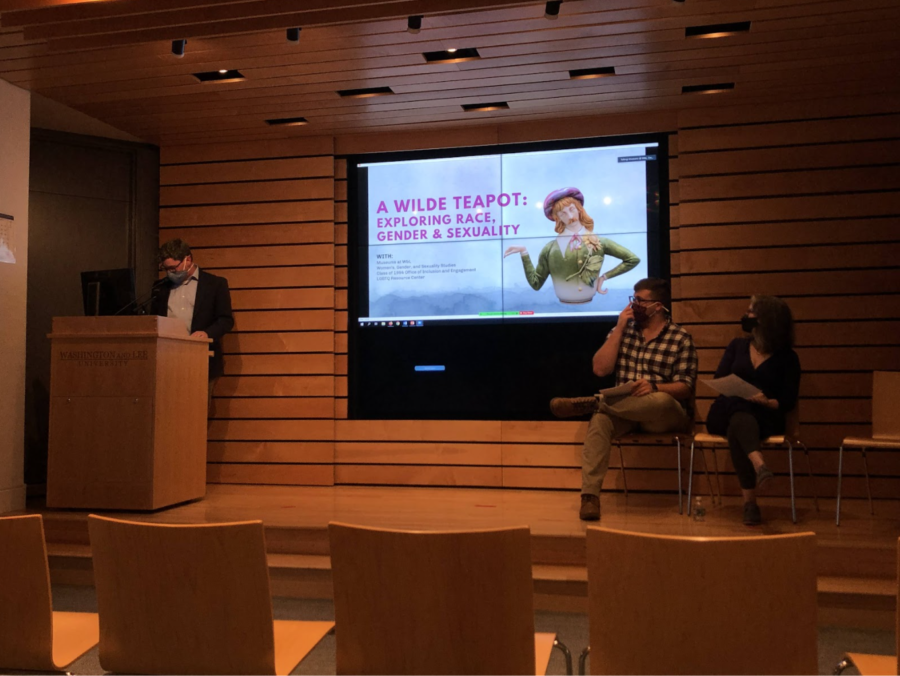Gallery talk covers race, gender, and teapots
The Museums at Washington and Lee University host talk on Oscar Wilde inspired teapot and the aesthetic movement.
Museums at Washington and Lee will host the next Gallery Talk on Nov. 2. Photo by Andrew Claybrook, ‘22.
October 26, 2021
“A Wilde Teapot: Exploring Race, Gender and Sexuality” posed the question “When is a teapot not just a teapot?”
The third Gallery Talk by the Museums at Washington and Lee University focused on a unique teapot from the Reeves Museum of Ceramics.
The event was held on Oct. 20 in Northen Auditorium.
The event was co-sponsored by the women’s, gender, and sexuality studies department, the LGBTQ+ Resource Center and the Office of Inclusion and Engagement as part of LGBTQ+ History Month since the titular teapot, its subject, Oscar Wilde, and the Aesthetic Movement are important parts of queer cultural history.
Ron Fuchs, Senior Curator of Ceramics in the Reeves Center, led the first section of the part-lecture, part-discussion. Fuchs discussed the physical history of the teapot and the Aesthetic Movement which the teapot both exemplifies and satirizes.
Sarah Horowitz, professor of history and head of the WGSS department, gave the second part of the lecture, discussing the historical context of the teapot and what it reveals about gendered and racial anxieties of the era.
Jake Reeves, assistant director of LGBTQ+ affairs, moderated the discussion following the lecture.
The teapot in discussion was designed by James Hadley in 1881 and produced by the Worcester Royal Porcelain Company.
The teapot is double-sided, molded to look like a man or woman depending on the side being viewed. Both wear green and have long red hair, one arm on their hip to form the handle of the teapot, and the other held to the side to form the spout.
On the man’s chest is a sunflower, and on the woman’s a calla lily, both symbols of the Aesthetic Movement to which the piece responds.
The Aesthetic Movement was an artistic movement in which art was praised for its inherent beauty and meant to speak for itself, but in its time, it was seen as indecent for its supposed emphasis on decadence.
In his lecture, Fuchs spoke on how the physical stature of the man on the teapot suggested “decadence, illness, and weakness,” all of which were unacceptable for men at the time
in Victorian England.
Horowitz noted that as the theory of Darwinism developed, there were concerns about the evolution or degeneracy of societies based on their ability to uphold Western societal norms.
The bottom of the teapot reads, “fearful consequences through the laws of natural selection and evolution of living up to one’s teapot,” invoking both Darwin and Wilde who was quoted for his difficulty trying to “live up to [his] blue and white China.”
Wilde was a burgeoning celebrity at the time, and he cultivated a personality of languid living which alarmed many of his contemporaries.
“There was an idea that a male celebrity’s level of manliness is bound up in the health of society and is speaking for social conditions,” Horowitz said. “The bottom inscription is an idea that if you live up to your teapot, if you’re that obsessed with your ceramics, then you’re not very manly… as a result there will be fearful consequences that somehow have to do with evolution and natural selection,”
Fuchs and Horowitz described the teapot’s commentary on perceived gender ambiguity and “devolving” gender norms of Victorian society by binding the male and female into one figure.
The man is seen as languishing and weak, something that was not permissible and invoked a racial and gendered fear. Many believed if the man was not upholding his status as a man, white, Western society itself was in peril.
In the 1800s, as imperialism spread out of England in particular, there was an emphasis on dominance over other cultures and races that were deemed inferior, often through the racist application of Darwinism.
There were also fears that if society was not moving forward, having children and raising them “correctly,” it would devolve and become degenerate. This was unacceptable to Victorian England’s self-image, which was used to justify its imperial conquests.
Aimee Rodriguez, 1L, attended the talk and praised the focus on “the complicated nuances between gender and race, and how those can be perceived in society in the context of the time.”
Fellow law students Taylor Parsons, 1L, and Julia Farbstein, 1L, said they appreciated having access to scholars on the subjects.
The next Gallery Talk “Kaleidoscopic Catlett” will be held on Nov. 2 at 6 p.m. in Northen Auditorium and focus on the work of Elizabeth Catlett.













